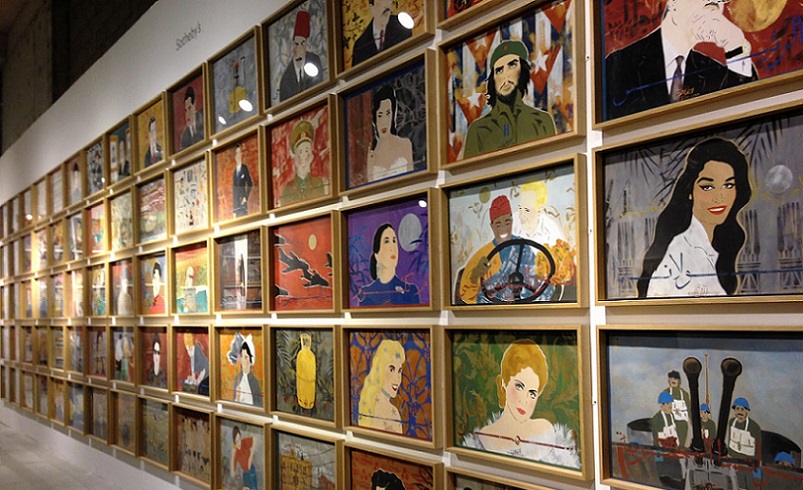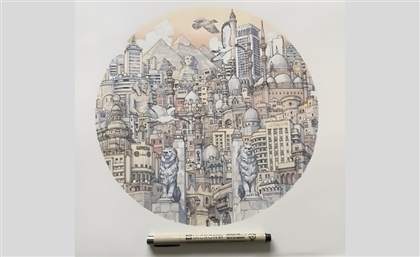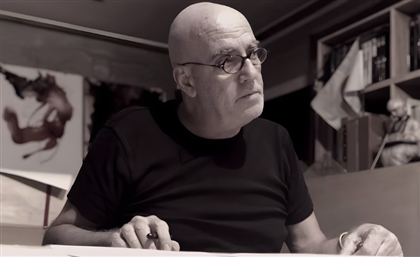Not Safe For Work: The Ins and Outs of Cairo's Modern Art Scene
Get your artsy fartsy pants on, because we're about to go for a contemporary ride.

Being a starving artist is one of those things that looks nicer on screen than it actually is in practice. It sounds pretty romantic, imagining a disheveled guy or girl in a small flat, living on modest portions of food and wine, and painting their life away in a perpetual state of aesthetically hot mess.
It’s never that romantic in Cairo, however. The streets are crowded, working hours are never definite, and by the time you get home, all you want to do is binge on Netflix, eat popcorn, and kill your time doing anything you can to unwind.
But as you scroll through your social media feeds, you find yourself liking photos of other people’s artworks—comic artists from your social circles, or someone from work who’s astounding with digital design. Everyone's had to start somewhere, and it takes a certain formula to attain success. Do you follow your heart, or your mind? Do you sell out, or stick to your own style?
We’ve compiled a comprehensive guide to help you answer these questions, and perchance, find your way. Here's what you should know as an artist living in Egypt, as well as what to do to expand, or overcome a creative slump.
SCULPTURES & CONTEMPORARY ART

Image taken from Mathaf Encylopedia of Modern Art and the Arab World
Egypt’s Art Movement started in 1920 with Mahmoud Mokhtar, one of Egypt’s most distinguished sculptors, known for fabricating renditions of nationalistic ideologies, with an artisanal edge. The contemporary influence came a long way since then. Mokhtar's figures usually have a Pharaonic element to them, giving the bodies of his sculptures elongated limbs.
In present-day Egypt, we still see a lot of the same elements that existed 61 years ago, albeit with a more western touch involving an explosion of colours, and bolder statements. Because the word contemporary reflects present-time - which is now the age of mobile phones, internet, and HD screens - the style of art has taken a giant leap, paving new ways for more outstanding artistic expression.
Contemporary art in Egypt develops with each generation, yet still holds on to the cultural elements.
Armen Agopis is another fine example of sculptors descending from Egypt, but based in Italy. Agopis designs black minimalist figurines from granite and basalt; the sculptures are beautiful in their simplicity.
A post shared by Armen Agop (@armen.agop) on
To delve into the intricate arts of sculpture-making, you can check out Place Des Arts - an art educational centre located within Maadi. The centre in itself has an exuberant and lively atmosphere, full of like-minded individuals interested in the arts. Sculpture Instructor Islam Sharqawy is exceptional with his easygoing attitude and simple instructions, helping you develop your skills to the very last step.
The educational centre also offers dynamic workshops in the fields of oil painting, comic art, music, and much more to get your creative juices flowin'.
GRAFFITI & WALL ART

Egypt’s prominent graffiti era is now gone, with the buzz of the 2011 Revolution becoming a thing of the past. However, we can also say goodbye to phone numbers being spray-painted onto walls, since a new wave of wall art took over Egypt, putting amateurs to shame.
Drawing on walls is a form of art that seems shady to many, given its rebellious nature and close ties with vandalism. However, artists can find opportunities where they can paint walls as colourful and as brightly as they (or their client) want to—and legally.
Women on Walls is a public wall-art initiative which tackles gender issues and societal problems. Co-founders Mia Grondahl (Swedish street-art documentarian) and Angie Balata (Egyptian artist) launched a month-long campaign for in the cities of Cairo, Luxor, Alexandria, and Mansoura in 2013, before assigning the artists to go back home, and take all that they’ve learned from the workshops to the streets and walls of their residences.
“The idea is not only to support women’s rights but also to encourage female graffiti artists and provide them with safe walls to do their art in peace,” Grondahl told Cairo Scene in a previous interview.
Jidar is another example of an Egyptian online platform which helps connect wall muralists to customers who'd like their walls painted. Do be careful of public vandalism, however; not everyone is as easygoing when it comes to having random strangers spray paint their walls with illustrations or an agenda.
ANIMATION, ART INSTALLATIONS & LIGHTS
 @ Alchem Studio
@ Alchem StudioAlchem Studios is one of the few design studios in Cairo that focus on digital media and interactive design. Founded by Islam Shabana and Yassan El Zo-bil, the pair base their work on CGI in form and other experimental practices and interactive art. All of that merged with a conceptual and colourful background ends up giving you some pretty trippy results.
Shabana has used experimental procedures like manipulating real-time images via brainwaves in both domestic and international settings. In 2016, Alchem Studios participated in the secluded desert of Fayoum for a one-of-a-kind arts and music festival.
If you want to get some insight into the world of visual arts, Alchem offers starter-level workshops throughout August, teaching you how to build your workflow and giving you an introduction to the essential 2D and 3D-animation tools and how to use them.
Or perhaps you don't want to go all out, and just want to settle for basic animation. There are four kinds of animation art: traditional (usually hand drawn), 2D (vector-based), 3D (CGI), motion graphics, and stop motion.
Nazyak is a popular Animation school with condensed curriculum for animation; their website is updated with each month's schedule, and a soft-on-the-eye brief on the tracks and courses that they offer, including Concert Art Diploma, Design Track, 3D Animation Diploma, and much more.

Toon Boom - which has branches all over the world, from the States to Japan - also offers a range of courses from digital art and character design, to using 3D Max and computer animation programmes.
After all, Egypt did start very early on in the global animation industry, beginning in 1939 with black-and-white cartoon series Mesh Mesh Afandi, following a Mickey Mouse-like character, except embodying a 100% Egyptian persona, facing issues like traffic, and speaking in a hilariously colloquial manner.
SOCIAL MEDIA

This one’s simple easy, right? Most of us are owners of some social media account or another, if not all of us. Social media is a subtle and inconspicuous way to give yourself some exposure, without having to make direct conversation with people you know nothing about.
“Not everyone has access to venues or galleries to display their work; if we relied on that, without social media, then only established artists would be able to do so, leaving minor chances for the younger ones,” Yehia O, the Art Doctor, told Cairo Scene. A part-time artist and part-time dentist, Yehia weighed the impact that social media has had on his exposure. “Social media has definitely cut short a lot of the circumstantial nature of art exposure.”
Social media has definitely cut short a lot of the circumstantial nature of art exposure.
Facebook makes it easy to advertise your work, and posts tend to go viral the more that the audience resonates with the content. While it’s easy to stick to your heart in regards to the content you’re creating, one must be aware of a balance between what the audience wants to see, and what you want to express.
Doing art that chiefly interests you may not “necessarily attract the needed audience or benefit you for the commercial and financial side of art making,” Yehia said.
A post shared by Yehia O (@ohsart) on
While going viral on social media may seem like something of luck, representation also contributes a huge factor to the success of an artist these days. Keep your eyes open for hashtags and trending topics in the area in order to keep in mind what your Egyptian or Cairene audience is interested in. Remember: the more Egyptian, the better.
I think my personality needs various outlets. Being a dentist is a good counter balance [to art] for me.
Art doesn't have to be a full-time job either in order to be done and recognised. When asked if he sees himself ever being a full-time artist, Yehia said, "I think my personality needs various outlets. Being a dentist is a good counter balance for me."
ART RESIDENCIES

Art residencies are a great way to travel, do art, and establish connections overseas. There are several kinds of art residencies, such as research trips, studio residencies, and collective residencies; some people prefer to do independent art, but if there are groups of people, artists sometimes end up collaborating and sharing ideas.
Pro Helvetia Cairo is a Swiss Residency programme, and promotes the exchange of artists between Switzerland and the Arab region. People usually stay for one to three months within a residency, depending on how much time they need to execute their project ideas. Some people also choose to apply for research residencies, where the sole purpose of the travel is not to do art, but to get the relevant information needed.
Aya Tarek is an Egyptian street artist you should be aware of if you have interests in the arts. A member of the Pro Helvetia Cairo programme, she’s traveled to Geneva to make murals for celebrations.
"Art Residencies are always great opportunities for any artist whose goal is to expand on their ideas," New York-based Egyptian visual and tattoo artist Gee El-Shaikh said. She's participated in art residencies located in Finland, Poland, and Spain. El-Shaikh adds that residencies serve as a space to not only create art, but also establish international connections and meet like-minded people from all over the world.
ART SCHOOLS & WORKSHOPS

By now, you should know that Cairo offers several art schools and workshops that lie outside of the college-tailored curriculum—which might or might not offer you much depending on your expected outcomes of the university you choose to go to. Besides, it’s quite difficult to dedicate an entire four years of college to the arts, when your baba wants you to be an engineer, and your mama a doctor.
Art is often seen by our parents as an attribute of laziness, something not worth investing your time into. Luckily, we live in a new age where workshops and classes are flourishing right and left, offering a wide range of artistic skills that give you more practical and hands-on practice than watching a YouTube tutorial video would normally do.
There are also less specialised institutes that offer a range of courses in a light and friendly environment to give you the room to express yourself freely. Arts Café in Maadi offers a “retreat to recharge” where both artists and beginners can participate in classes like candle-making, crochet, fashion design, Arabic calligraphy, and a lot more.
There is probably an infinite amount of ways to create art—and all the more so now that we’re living in a contemporary age, where experimenting with art is praised, and the absurd is looked up to. If you’re successful in your ventures in becoming an artist, or overcoming that creative block, then don’t be shy to show off your work on the interwebz; it’s where most artists get their exposure. There are also Egyptian platforms like Arts-Mart which allow for submissions of artwork, and act as a vendor for your artwork to be sold at.
Main image from MO4 Network @ Chant Avedissian (Egyptian-Armenian Artist) Exhibition.
























